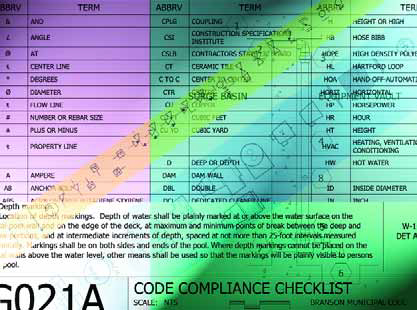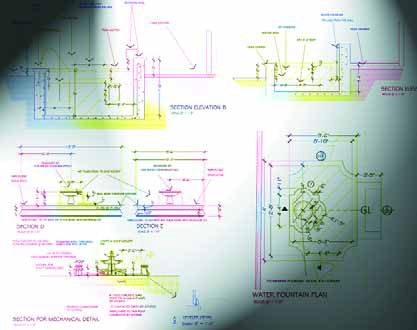Professional Watershaping
Through the past year and a half, I’ve dedicated four “Currents” columns to the subject of drawing practices and the National CAD Standards. But construction documents consist not only of drawings, but also written specifications – so now I’ll shift my attention to Project Manuals – key communication tools used by architects and engineers to uphold quality and establish performance requirements for all of a given project’s contractors. Basically, a Project Manual is a bound book of construction documents prepared to define
As winter draws to a close here in the northeast, we begin preparing in earnest to deal with the inevitable springtime rush. There are contracts to sign, materials to order, plants to grow, schedules to set and hires (if any) to be made. And we do all of this knowing that, once the weather breaks, we want to burst out of the gate like an odds-on favorite at the Kentucky Derby. To make this happen, we need to be ready. Where I live and work, winters are usually long, so by spring our coffers are low, our staff is eager to get some exercise and our general desire to
One of the longest-standing knocks against the pool and spa industry is that too many designers and builders rely too heavily on convention and seem disinclined to pursue new paths and ideas no matter how compelling they might be. Of course there are exceptions, but there’s a lot of truth to that statement when it comes to the technology chosen, for example, to drive circulation systems and chemically treat or light the water: All too often, pool and spa professionals tend to keep on specifying and installing equipment they’ve used for years – even if it’s outmoded or is no longer the best available approach – because they feel comfortable with it and
One of the greatest epiphanies I’ve ever had as a watershaper came many years ago when I was asked to tell a group of businesspeople what I did for a living. I’d been invited to attend a meeting of the Miami Chamber of Commerce and, as a newcomer, was asked to say a few words about my company and my work. I was to go second: The first speaker was in the carpet-cleaning business and, as I recall vividly, described what he did in such a way that it would’ve been a great cure for insomnia. Standing up after his sleep-inducing performance, I was
As is true of many business sectors, the architecture, engineering and construction industry (commonly and conveniently abbreviated as A/E/C) has its own language – and the construction documents generated by those professionals (watershapers very definitely included) are the medium through which everyone communicates. The challenge for watershapers is that we’ve come to the table a bit later than
The availability of new and different materials has been a driving force behind the design revolution that has defined the watershaping industry for the past ten years. One key to that development, observes Kirk Butler of Cactus Stone & Tile, has been the willingness of suppliers to step into more progressive roles as purveyors of unique products that have blown the creative process wide open for watershape designers and builders – and their clients. In our business as a stone and tile supplier, we’ve often heard in the past 35 years that designers and contractors get tired of repetition: They come to us, they say, hoping to find things that inspire them to create projects that are new, unique and exciting. Frankly, we on the supply side are subject to the same sentiment: While we may be intimately familiar with materials our designers and builders have used over and over again and have no objection to working with the tried and true, we’re restless, too, and are always trying to find something new to bring to the table. Whether we’re working with a pool designer, a landscape architect, an interior designer, a home builder or even a homeowner, we believe everyone benefits from access to a wide array of quality products and materials. In our case at Cactus Stone & Tile (Phoenix, Ariz.), this means we literally travel the world to find and procure the widest possible range of hard-surface products, be it stone or tile. We beat the bushes across Europe and Asia and visit the far reaches of South America, dropping in on trade shows and fairs, introducing ourselves at quarries and processing facilities and doing whatever it takes to
Through the past several months, we’ve heard all sorts of voices discussing the current state of economic affairs – including mine in last month’s “Aqua Culture” column, but, more predominantly, those of representatives of the 24-hour-a-day news media. Anyone who isn’t living in a cave is by now aware that we’re caught up in an economic crisis of global proportions and that the consequences may be dire. We’ve heard that line so often and with such fervor, in fact, that it’s
If you’re paying even the slightest bit of attention to the world at large, you’ve probably heard more than you ever wanted to know about current economic conditions. Indeed, everything that has happened in the past year or so with both our national and the global economy has made it hard for some people to think optimistically about the future. These are perilous times, as some say, and in one way or another, I know we’re all being affected by what’s going on. But that doesn’t seem to be the whole story. In fact,
What happens when you take a large group of landscape architecture students and, for a solid week, rigorously school them in the fundamentals of watershaping? You might be surprised: Even though that seems like a short span, my charges took to watershaping like fish to water when I introduced them to the subject this past spring - and the results were both remarkable and inspiring. As their instructor, I witnessed not only their keen interest but also saw ample evidence that they were applying highly refined design processes and quality design productions in their watershape-related coursework. So despite what some skeptics have been telling me for years, you actually can
Several years back, I was in a seminar at the International Pool & Spa Expo when the instructor asked everyone who had an e-mail address to raise a hand. Way back then - it was in the late 1980s or perhaps even the early '90s - using the Internet for communication was a brand-new concept to most people and there were only a few people in the room who lifted an arm. I wasn't one of them, and at that point I had no idea that e-mail and Web sites would ever become such an integral part of my life. At that time, in fact, I didn't think I'd ever need an e-mail address. After all, I






















